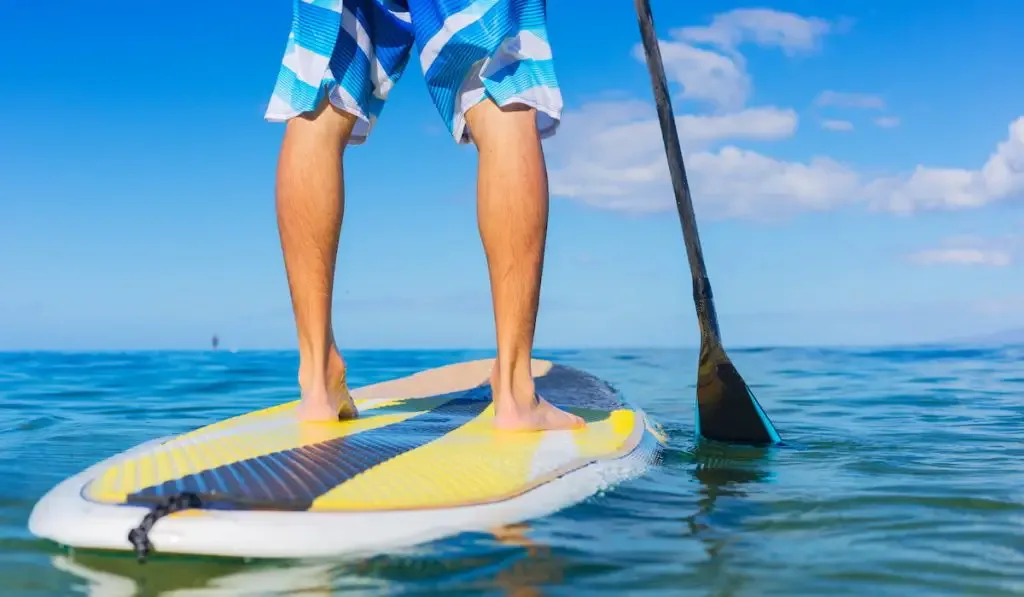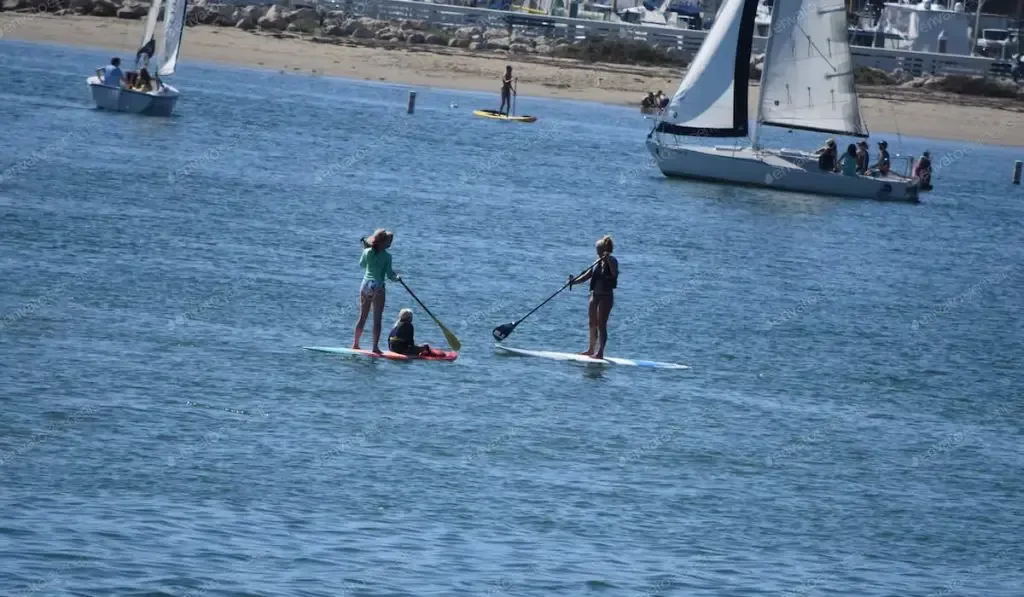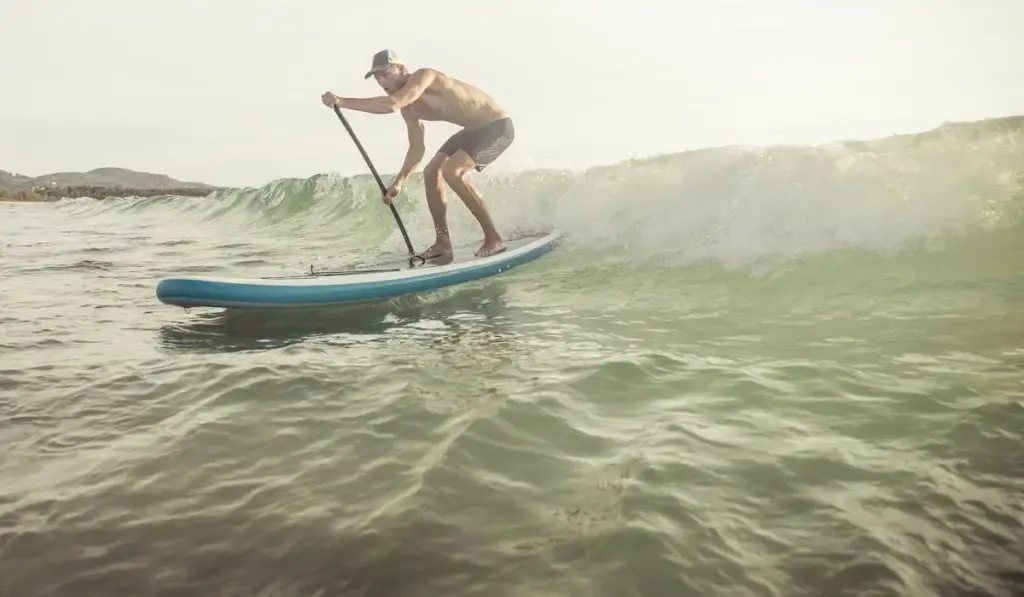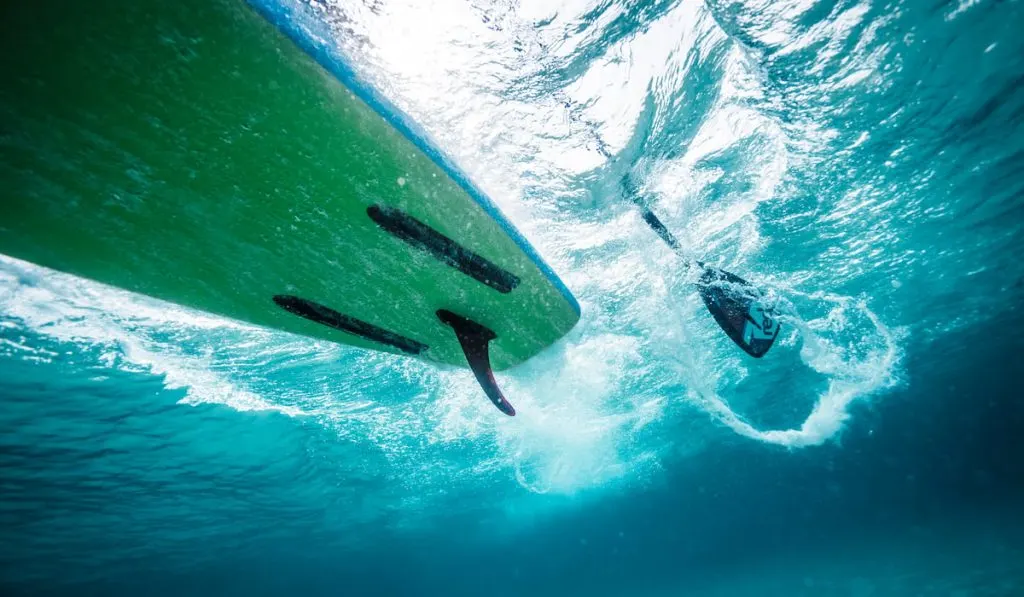People who are new to stand-up paddleboarding, or SUP, usually start in lakes whenever possible. They are generally calmer bodies of water with less to worry about. You can practice getting on and off, steering your paddleboard, and making sure you know what to do when certain circumstances arise.
But can you go paddleboarding in the ocean?
Absolutely! Ocean SUP is a fantastic way to enjoy the beach and explore areas like coves and lagoons while you get some exercise.

People paddleboard in the ocean with friends or in groups, or they go exploring alone. Things are a bit different in the ocean in terms of water conditions and safety concerns, but it’s still a great way to enjoy your board.
There are things you should be aware of if you’re never been paddleboarding in the ocean before. For one thing, balancing while you deal with waves is going to be a whole new experience.
If you’re planning on taking the paddleboard to the beach, here are some things that will help you have a great time.
Dealing with Waves in the Ocean
The ocean can be very challenging for paddleboarders because the water is often unpredictable. This isn’t said to discourage people from getting out on their boards. Instead, you can expect a workout whenever you paddleboard on the ocean.
You’re probably going to be far out from the beach, past the wave break and where the water is much more stable. That’s going to take some work to get out there, and you should be a relatively strong swimmer if you want to try. That, or you can find a beach that typically has very small waves and launch from there.
One thing you should do before any paddleboarding trip in the ocean is to check local weather and wave reports. Most popular beaches maintain robust reporting systems where you can check on water conditions before you even leave your house. You’ll know what to expect before you head to the beach and can plan properly ahead of time.
When you’re on the water, you’re going to be dealing with bigger waves than you’re used to on the lake.

Navigating Around Other Vessels
Depending on where you live or where you are ocean SUPing, you’re probably going to see a lot of other vessels on the water. Popular beaches, for example, are full of jet skis, boats, people fishing, swimming, and other obstacles that will get in your way.
If you are relatively new to paddleboarding, you should choose a more secluded area of the beach to start in where you can learn how to pivot more quickly and avoid any collisions. Once you become more comfortable on your board, then you can start going into more high-traffic areas of the beach.
Bringing the Right Gear for Ocean SUP
When you’re out on the ocean, you need to be even more safety conscious than you would on a lake or any other body of water. The stakes are typically higher for paddleboarders on the ocean. You’re managing currents, weather that can change quickly, and a host of other concerns.
It shouldn’t stop you from going out, but you need the right gear to make your trip successful.
Here are some things to consider:
- Always wear a life vest – A life vest should be on your body the whole time you are out on the water. If you fall off your board at the wrong moment, you might get caught in waves or damage your board. You may have to float or swim a bit until conditions calm or you get to a better spot before you can get back on your board. Buy a life vest that fits you and that you can keep on all day.
- Wear a board leash – Not wearing your leash isn’t such a big deal at the lake. There is nowhere that your board can really go if you fall off and it goes shooting in the other direction. In the ocean, your board can theoretically travel for thousands of miles.
Even if it only goes several feet from you, you may have a hard time chasing it down. A leash that attaches your board to your ankle will ensure that it stays close at all times.
- Bring a hat – If you’re out on the ocean, you should think about bringing a hat. The ocean doesn’t have trees lining it on all sides as many lakes do, so the effects of the sun are more severe. If you are out on the water for hours, you could get heat exhaustion and dehydrate.
The main point here is that, typically, you’re going to be farther from the shore on the ocean than in a lake, so if you start feeling dizzy or fatigued, it’s going to take some effort and time to get back to the beach. Wearing a hat is a smart way to block the sun and protect your head.
- Think about a wetsuit – Whether you use a wetsuit or not will usually depend on how cold things are and where you are paddleboarding. For example, SUP paddleboarding in the Pacific Northwest is much different than paddleboarding in Miami.
You’re dealing with colder water temperatures even on hot days. If you are relatively new to ocean paddleboarding, you’re going to fall in the water at some point.
Plan on it. When you fall in and get back on your board, you could turn cold very quickly. Wearing a wetsuit can help you maintain body heat better and avoid any sort of hypothermia while you’re out there.

Expect a Better Workout
One thing you can plan on when you ocean SUP is a better workout! Your body is going to have to compensate for every natural wave and every ripple caused by a passing boat or a jet ski. Your leg muscles and your core will probably be sore for a while after your first few forays into the ocean.
You may want to plan a shorter trip than your typical trip to the lake. Knowing that you’re going to be working harder, you may also want to stay a little closer to the shore. If you go too far out and get exhausted, you may struggle to get back.
It’s a good idea to take a buddy or go with a group the first few times you ocean SUP. They will be there to help you when anything goes awry, and hopefully, they will have some sort of ocean experience that will guide you away from any problems to ensure a successful trip.
You will likely also experience more mental fatigue from SUP in the ocean. Your brain is going to be on alert the entire time.
You’ll be watching for boats, swimmers, other boarders, as well as obstacles and things that are under the water. Managing all that will wear you out faster than you’d think.

Sharks and Other Sea Creatures
We have to talk about sharks because that’s what most new ocean paddleboarders think about when they consider going out on their boards.
Shark attacks are very rare, but they have attacked paddleboarders in the past. It’s important to remember that humans are not shark food.
Sharks don’t want to eat humans as food. Shark attacks typically happen when a shark mistakes a board, a surfer, or someone else in the water for a seal or a dead whale or something else they would eat.
In past cases of shark attacks on paddleboarders, sharks have taken a chunk out of the board and usually swim away shortly thereafter.
When you are in the ocean, there are creatures of all sizes underneath you. It’s part of being in their ecosystem. If you do see a shark, you should remain calm and start paddling to shore.
Don’t try to get aggressive with the shark or start splashing in the water. You could end up falling in and then you’re in even more trouble.
Most beaches do a great job of receiving and relaying shark sightings. Check your beach before you launch so you know what’s in your area.
Sharks are not the only creatures in the ocean. Just do a quick YouTube search, and you’ll see some amazing interactions between paddleboarders, kayakers, and other sporters with ocean animals. For the most part, you’ll probably want to be aware of jellyfish in the area, and whether you’re paddling on top of any coral reefs.
Again, bad experiences with animals are very rare. If you’re concerned, you can stay in shallower waters or around sandbars that make it difficult for large fish to get in close. Paddle in clear waters where it’s easier to see what’s in your way.
Paddleboarding in the ocean is a ton of fun! It’s great exercise and a wonderful way to explore caves, lagoons, and other places that are hard to get to on foot. You’ll get a new perspective on your environment as you get a fantastic workout.
